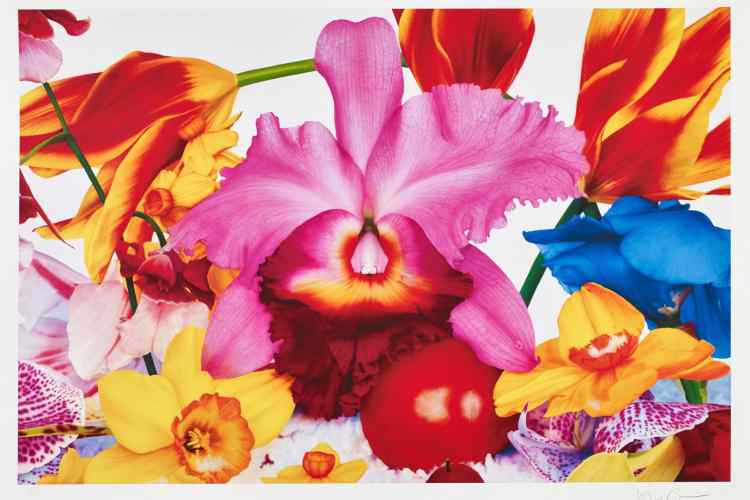Works[edit]
"Self" (ongoing project)[edit]
"Self" is a frozen sculpture of the artist's head made from 5 litres of his own blood, taken from his body over a period of five months, the first of which was made in 1991. Described by Quinn as a "frozen moment on lifesupport", the work is carefully maintained in a refrigeration unit, reminding the viewer of the fragility of existence. Quinn makes a new version of Self every five years, each of which documents Quinn’s own aging and physical deterioration.
It was purchased by Charles Saatchi in 1991 for £13,000, who displayed it in the "Sensation" exhibit at the Royal Academy of Arts in 1997. There were rumors that the piece had melted, but Saatchi dispelled those rumors when he exhibited it at his new gallery in London in 2003.[7]
In April 2005 he sold it to Steven A. Cohen, the American hedge-fund manager of Point72 Asset Management (formerly S.A.C.), for $2.8 million.[8] Cohen displayed it at his hedge fund's headquarters in Stamford, Connecticut.[9] The National Portrait Gallery in London acquired Self 2006, purchased through The Art Fund, the Henry Moore Foundation, Terry and Jean de Gunzburg and Project B Contemporary Art, 2009.
Garden (2000)[edit]
'Eternal Spring - Sunflowers II', sunflowers kept chilled in liquid silicone oil
His next important piece in terms of his public profile was the frozen garden he made for Miuccia Prada in 2000, installed at Fondazione Prada in Milan, Italy. A whole garden full of plants which could never grow together kept in cryogenic suspension. In interview, Quinn explained how this worked, "When working with the frozen material, it’s like doing an experiment—different things come out of it. When you freeze something, it normally dries up. To avoid that, you have to stop the air from getting to the object. You can do this by casing it in silicone".
Portrait of John E. Sulston (2001)[edit]
His portrait of John E. Sulston, who won the Nobel prize in 2002 for sequencing the human genome on the Human Genome Project,[10] is in the National Portrait Gallery. It consists of bacteria containing Sulston's DNA in agar jelly. "The portrait was made by our standard methods for DNA cloning", writes Sulston. "My DNA was broken randomly into segments, and treated so that they could be replicated in bacteria. The bacteria containing the DNA segments were spread out on agar jelly in the plate you see in the portrait."[11]
Alison Lapper, The Fourth Plinth (2005–2007)[edit]
Quinn has made a series of marble sculptures of people either born with limbs missing or who have had them amputated. This culminated in his 15-ton marble statue of Alison Lapper, a fellow artist born with no arms and severely shortened legs, which was displayed on the fourth plinth in Trafalgar Square, London from September 2005 until October 2007.[12] (The Fourth Plinth is used for rotating displays of sculpture.) In Disability Studies Quarterly, Ann Millett writes, "The work has been highly criticized for capitalizing on the shock value of disability, as well as lauded for its progressive social values. Alison Lapper Pregnant and the controversy surrounding it showcase disability issues at the forefront of current debates in contemporary art".[13]
A large reproduction of the sculpture was used as a central element of the 2012 Summer Paralympics opening ceremony.[14][15]
Siren (2008)[edit]
Since 2006, Marc Quinn has made numerous studies of the supermodel Kate Moss. In April 2006, Sphinx, a sculpture of Kate Moss by Quinn was revealed.[16] The sculpture shows Moss in a yoga position with her ankles and arms wrapped behind her ears. This body of work culminated in an exhibition at the Mary Boone Gallery in New York in May 2007. The sculpture is on permanent display in Folketeatret in Oslo, Norway.[17][18]
In August 2008, Quinn unveiled another sculpture of Kate Moss in solid 18-carat gold called Siren, which was exhibited at the British Museum in London. The life-size sculpture was promoted as "the largest gold statue since ancient Egypt".
The Toxic Sublime (2015)[edit]
In 2015 Marc Quinn opened an exhibition of new work at White Cube Bermondsey, entitled The Toxic Sublime. It featured new bodies of work that explore the ecological impact of man on nature. ‘The Toxic Sublimes’ are distorted, three dimensional seascapes. Alongside these paintings, a new series of sculptures, cast in stainless steel and white concrete, including one measuring over 7.5 meters long, form part of a body of work titled ‘Frozen Waves’. The sculptures originate from the core of shells, eroded by the endless action of waves.





